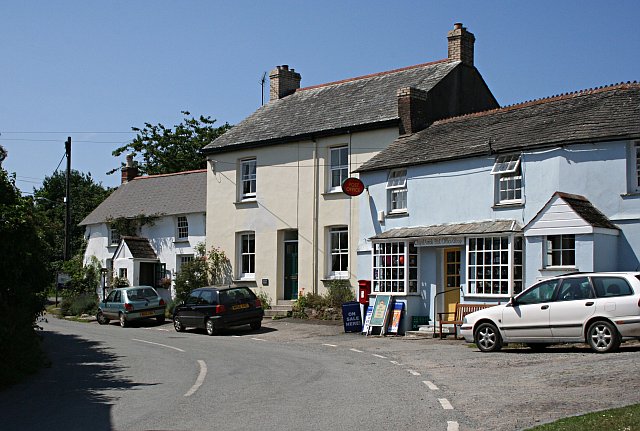Chapel Amble on:
[Wikipedia]
[Google]
[Amazon]
 Chapel Amble (, meaning ''church on the river Amble'') is a village in the civil parish of , north
Chapel Amble (, meaning ''church on the river Amble'') is a village in the civil parish of , north
 Chapel Amble (, meaning ''church on the river Amble'') is a village in the civil parish of , north
Chapel Amble (, meaning ''church on the river Amble'') is a village in the civil parish of , north Cornwall
Cornwall (; or ) is a Ceremonial counties of England, ceremonial county in South West England. It is also one of the Celtic nations and the homeland of the Cornish people. The county is bordered by the Atlantic Ocean to the north and west, ...
, England, United Kingdom. It is situated north of Wadebridge
Wadebridge (; ) is a town and civil parishes in England, civil parish in north Cornwall, England, United Kingdom. The town straddles the River Camel upstream from Padstow.Ordnance Survey: Landranger map sheet 200 ''Newquay & Bodmin'' The pe ...
next to the River Amble, a tributary of the River Camel
The River Camel (, meaning ''crooked river'') is a river in Cornwall, England. It rises on the edge of Bodmin Moor and with its tributaries its catchment area covers much of North Cornwall. The river flows into the eastern Celtic Sea between ...
. The oldest part of the village lies on rising ground facing south-east across the river.
History
Despite being a small village, Chapel Amble appeared in the national press in 2002 after the murder of a local farmer. The fact that a newspaper reporter was a local resident probably assisted in this receiving so much attention. The article dates the village back to at least 1373, although the earliest written mention of Chapel Amble is in the ''Domesday Book
Domesday Book ( ; the Middle English spelling of "Doomsday Book") is a manuscript record of the Great Survey of much of England and parts of Wales completed in 1086 at the behest of William the Conqueror. The manuscript was originally known by ...
'' where 'Amal' was held by Thurstan from Robert, Count of Mortain
Robert, Count of Mortain, first Earl of Cornwall of 2nd creation (–) was a Norman nobleman and the half-brother (on their mother's side) of King William the Conqueror. He was one of the very few proven companions of William the Conqueror at t ...
.
The earliest record of the name "Amaleglos" is in 1284. The name "Amble" is derived from the Cornish "Amal", i.e. "edge" or "boundary" and is the name of a tributary of the Camel. As "eglos" is the Cornish for "church" there must already have been a chapel here; in 1383 a chapel of St Aldhelm
Aldhelm (, ; 25 May 709), Abbot of Malmesbury Abbey, Bishop of Sherborne, and a writer and scholar of Latin poetry, was born before the middle of the 7th century. He is said to have been the son of Kenten, who was of the royal house of Wessex ...
was licensed.
Despite the indications of an earlier chapel, a Methodist society started in Chapel Amble in 1784 and 50 years later had 30 members. There were groups of two different streams of Methodism; Bible Christians and the United Methodist Free Church, and as a result there were two separate Methodist chapels in the village with a total capacity of 250. The chapels, which are both Grade II listed, closed between 1987 and 1991 and have since been converted for residential use. Apart from the old chapels, there are three other listed building in Chapel Amble. The oldest is an 18th-century house in the village itself, and slightly later are the old forge and a 19th-century barn located across the river from the village.
River Amble
The River Amble was once navigable up to the village on high spring tides, with seaweed, sand and coal being taken up to the village and grain brought out again. Access to the River Amble for vessels is not now possible after construction of the tidal barrage which prevents the tide entering the river in 1963. The area at the foot of the slope below the village was once known as "the beach" and was used for leisure activities such ascricket
Cricket is a Bat-and-ball games, bat-and-ball game played between two Sports team, teams of eleven players on a cricket field, field, at the centre of which is a cricket pitch, pitch with a wicket at each end, each comprising two Bail (cr ...
.
Despite the tidal barrage preventing salt water from being pushed up by the tide, this low-lying area regularly floods in winter and this plus the wet meadows around the River Amble near the village are good for birdwatching, with the location regularly appearing on lists of bird sightings published by the Cornwall Birdwatching and Preservation Society
The Cornwall BirdWatching and Preservation Society is a conservation body dedicated to the preservation and enjoyment of birds in the county of Cornwall, England, UK. The society is involved in the management of six reserves, and provides news o ...
References
Citations
References
* *External links
{{authority control Villages in Cornwall